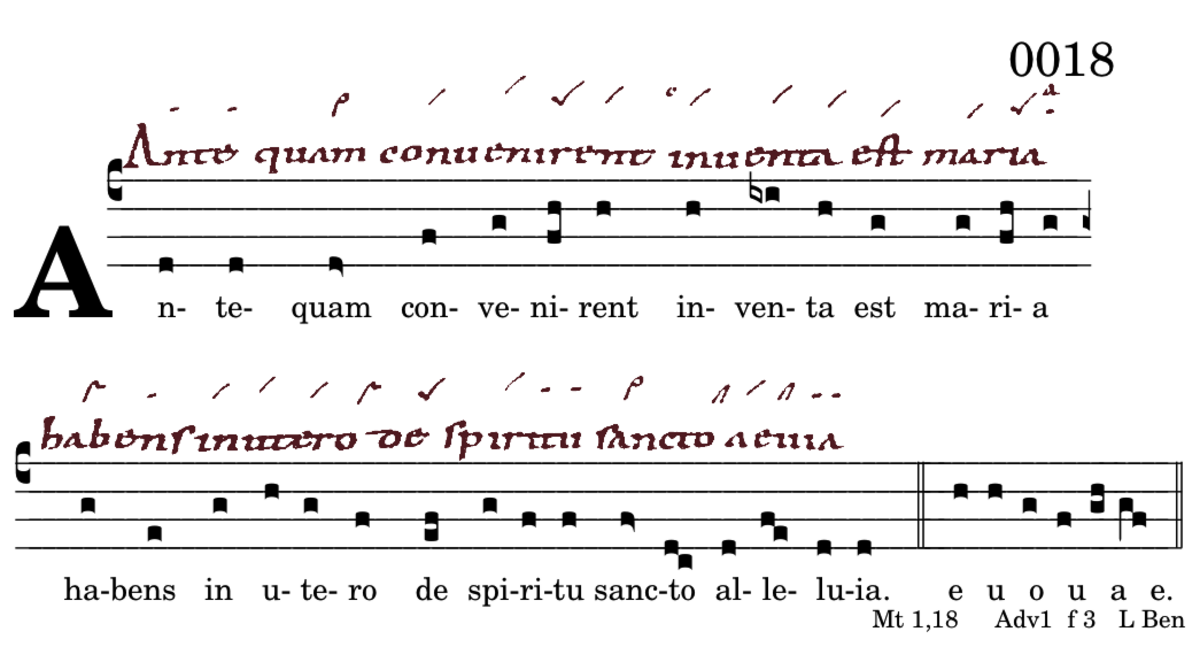🔘 IN GR TR AL OF CO xxxxx ✅ 2️⃣ 0️⃣ 3️⃣ 4️⃣ 5️⃣ 6️⃣ 7️⃣ 8️⃣ xxxxx AN RP IV alia
0018 AN Antequam convenirentModus 1
Klassischer Typos Protus authenticus
1INC Clv hat die Clivis zum Cephalicus reduziert, daher leichter Stau vor und Betonung des nächsten Wortes „convenírent“.
celeriter am Centoübergang treibt weiter.
1MED typ auftaktig. Die Hauptaussage der Antiphon kommt auf das „sa“ zu liegen „invénta est“, Normalform.
1NOV typ 2x
~Vrg mut (Virga strata mutans): nächster Cento beginnt: „ha-bens in ute-ro de spiritu sancto“.
Die übliche Deutung der Virga strata als Halbton-Pes oder doppelter, längerer Ton ist hier widerlegt: Keine Handschrift schreibt anders als einen gewöhnlichen Einzelton.
1TER de3
1TER v.add) Das nachgestellte „alleluia“ fordert das ein.
Auch zum Quilisma ist diese Antiphon aufschlussreich. Zweimal schreibt MR Quilisma, wo H einen leeren Terzpes schreibt. H hat die Eigenschaft, eine Neume bei ihrem ersten Erscheinen genau zu beschreiben, bei späteren Wiederholungen diese Kenntnis aber vorauszusetzen. Der Cento 1INC Clv mit Terzpes (Paroxytonon) kommt hier bereits zum zweiten Mal vor. Beim ersten Mal (0014) schreibt H das Quilisma. In
1MED typ hat das altius am Ende des Terzpes die selbe Funktion. Dieser Cento steht hier zum ersten mal unverziert.
1NOV typ
Die Terminatio verschmilzt zwei Formen: Sie beginnt als
1TER de3 kippt aber dann um in
1TER v.add. Das hinzugefügte Wort ist, wie meist, das „alleluia“. An der 1TER verb.add sind unterschiedliche Dosierungen abzulesen. Während Lc die Normalform bringt – drei Clives lassen den Sprachfluss ruhig und stetig zum Ende fließen –, reduziert H die erste Clivis zum Cephalicus, staut und betont somit das Wort „sáncto“. Codex T2 verstärkt den Stau, indem er auch die zweite Clivis reduziert, es bleibt nur das „do“ über.
● Bevor sie noch zusammengekommen waren fand es sich, dass Maria i n ihrem Leib hatte vom heiligen Geist,
● Before they had even come together, it was found that Mary had the Holy Spirit in her womb,
Classical Typos Protus authenticus
1INC Clv has reduced the clivis to cephalicus, hence slight congestion before and emphasis on the next word „convenírent“.
celeriter at the cento junction continues.
1MED typ upbeat. The main message of the antiphon comes to rest on the „sa“ „invénta est“, normal form.
1NOV typ 2x
~Vrg mut (Virga strata mutans): next cento begins: „ha-bens in ute-ro de spiritu sancto“.
The usual interpretation of the virga strata as a semitone pes or double, longer tone is refuted here: No manuscript writes other than an ordinary single tone.
1TER de3
1TER v.add) The trailing „alleluia“ demands this.
This antiphon is also informative for Quilisma. Twice MR writes quilisma where H writes an empty terzpes. H has the property of describing a neume precisely when it first appears, but assuming this knowledge in later repetitions. The cento 1INC Clv with terzpes (paroxytonon) occurs here for the second time. The first time (0014), H writes the quilisma. In
1MED typ the altius at the end of the tercet has the same function. This cento is unornamented here for the first time.
1NOV type
The Terminatio merges two forms: It begins as
1TER de3 but then turns into
1TER v.add. The added word is, as usual, „alleluia“. Different dosages can be read from the 1TER verb.add. While Lc brings the normal form - three clives allow the flow of speech to flow calmly and steadily to the end - H reduces the first clivis to cephalicus, thus congesting and emphasising the word „sáncto“. Codex T2 reinforces the congestion by also reducing the second clivis, leaving only the „do“.


